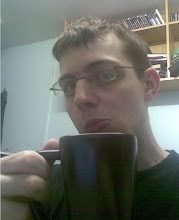Week three was designated as the point that we were to begin our production stage, with many members of the group shifting their main focus to the construction of assets in Maya for importing into the Torque engine, while the rest focused their attention on finishing off the concept art. I was tasked with conceptualising the tempora opponents for Chrono to fight during the game, a task I wanted to complete quickly, as Hannah was in the process of creating the final design art pieces and “T-Pose” sheets for all characters. Fortunately I was able to look back on my earlier brainstorming ideas to form the foundation of my ideas.
I had always imagined tempora as a very old group, and considered the idea of their agents being very old themselves, kept alive through artificial means (magical or technological). My main inspiration for this approach came, once again from a games workshop source; in this case the Warhammer 40’000 universe, where several of the famous characters are still alive well beyond natural age, maintained by archaic, cybernetic implants, gene therapy, or magical assistance. I imagined Tempora’s agents to have systems that were much less archaic and bulky than the examples in 40K, but I nevertheless found myself drawn to the warhammer approach of making the Tempora’s skin extremely pale and wrinkled to show their unnatural life, and so incorporated this into my designs.


In addition to the inspiration from Warhammer, I looked for examples of an elderly face, so as to collect ideas as to the bone structure, skin complexion, and facial expression, all of which I found can vary quite widely between different people, and is sometimes quite a degree different to the facial structures of a younger person.
My idea for these enemies was that, physically frailer than most enemies, they rely on technology and perhaps even magic to complete operations, so lots of systems and equipment would likely be visible on their form. Hannah had also made a request for characters to have some kind of mask or some such to obscure their faces (namely the eyes) slightly, so that a model can be used multiple times without the cloning being noticeable.


However, it noticed that my design, though interesting, would require a lot of modelling, and as their face was mostly exposed each elder would likely have to be a different model. So I decided to reconsider these ‘elders’ as a kind of “sub-boss” for the game; Chrono would only encounter two or three in a level, and design other, more generic enemies for Chrono to commonly encounter. This is what inspired a slight modification to the original concept and the introduction of Tempora “initiates”; younger Tempora agents (visible on the far left of the concepts) who would operate in groups, coordinated by an elder. Initiates would focus on direct physical attacks, having younger more agile bodies than the elders, and less trusted with the advanced technology or magic’s that the elders used. These could wear masks to cover themselves, or perhaps the storyline could explain them to be clones created purely to serve the elders, thus allowing them to look alike in-game.
With regards to personalities, i imagined the eldars as being somewhat remeniscent of the classic sterotypical "old strict schoolteacher", bossing others around and snapping at Chrono as they unleash thei attacks with such curses as "Pretulent child!" or "Brat!". The Initiates, meanwhile, would be more like the stereotypical bully or "chav/townie" sort of character; making sneery remarks and showing off all the time while teasing Chrono, which i felt would give the player more satisfaction when he defeats them.
---
Unfortunately, some technical issues with E-Mail meant the images did no make it to Hannah till the Thursday (I had intended to get them in Wednesday), and during the wait she had found herself considering ideas of her own for the enemies. When she did receive my concepts, she really loved the ideas, but felt that they were “a little too serious” (which I am highly prone too, as ‘nitty-gritty’ games are my focus), and may feel out of place in the highly cartoony world being devised. I did not mind this, and I found myself quite drawn to her design for the enemies too – large, black creatures – and her idea of them attempting to masquerade alongside the guards I had designed earlier (which they fail at as their bodies are far too big for the uniforms). We therefore decided to go with that idea instead and scrap the Eldar/Initiate idea. I found myself quite liking the designs however, and so may make use of them in a later game concept.
